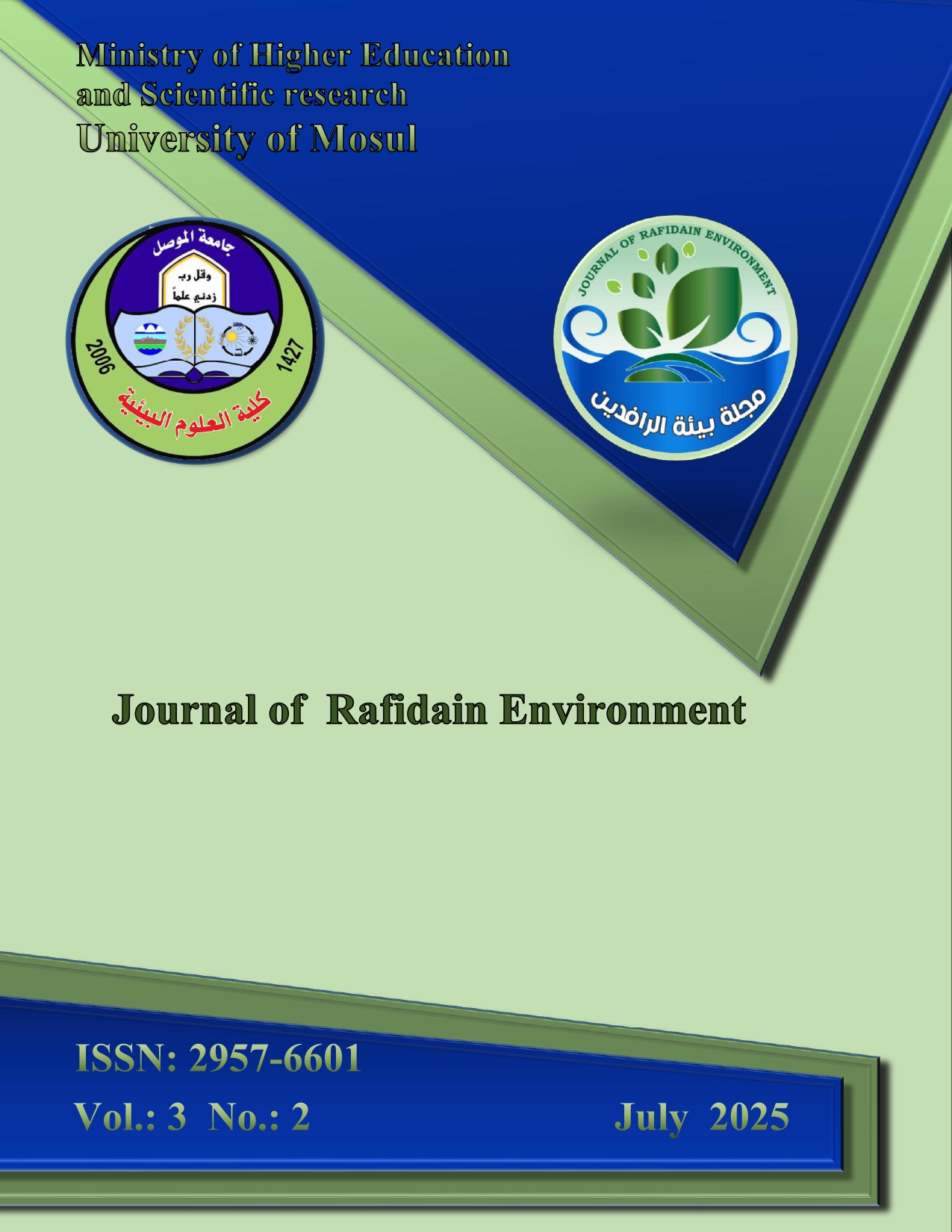التقييم البيئي ومعالجة مياه آبار كركوك باستخدام الفحم النشط وقشور الجوز
القسم: Research Article

منشور
Oct 6, 2025##editor.issues.pages##
49-59الملخص
في هذه الدراسة تم إجراء مسح وتحليل ميداني لمياه (12) بئراً تقع في مدينة كركوك وتستخدم لري الحدائق ، وقد أثبتت الدراسة أن مياه جميع الآبار في مواقع الدراسة مناسبة الري ، ولكن أظهرت بعض نتائج تلك الآبار زيادة في قيم النتائج مثل (SO4) و (Cl-) والعسرة الكلية ، في هذا البحث تم اقتراح طريقتين لمعالجة نماذج الآبار قيد الدراسة باستخدام قشور الجوز والفحم المنشط لتقليل نسبة التراكيز ومقارنة النتائج قبل وبعد المعالجة ، حيث أظهرت النتائج انخفاضًا في تراكيز الملوثات لهذ العينات من خلال عملية الامتزاز الكيميائي للعينات.
المراجع
- Konstantina,K., Hrissi K Karapanagioti,. Surface Water and Groundwater Sources for Drinking Water, Springer International Publishing, DOI 10.1007/698-140,(2017).
- Mekonnen, M. M., and Hoekstra, A. Y. (2016). Four billion people facing severe water scarcity. Sci. Adv. 2:e1500323. doi: 10.1126/sciadv.1500323.
- Falkenmark, M., Wang-Erlandsson, L., and Rockström, J. (2019). Understanding of water resilience in the Anthropocene. J. Hydrol. X 2:100009.
- Boers, N., Marwan, N., Barbosa, H. M., and Kurths, J. (2017). A deforestation-induced tipping point for the South American monsoon system. Sci. Rep.
- Ellison, D., Morris, C. E., Locatelli, B., Sheil, D., Cohen, J., Murdiyarso, D., et al. (2017). Trees, forests and water: Cool insights for a hot world. Glob. Environ. Change 43, 51–61. doi: 10.1016/j.gloenvcha.2017.01.002.
- Jain, S., Kumar, V., and Saharia, M. (2013). Analysis of rainfall and temperature trends in northeast India. Int. J. Climatol. 33, 968–978. doi: 10.1002/joc.3483.
- Rao, N. S., Sunitha, B., Adimalla, N., and Chaudhary, M. (2020). Quality criteria for groundwater use froma rural part of Wanaparthy District, Telangana State, India, through ionic spatial distribution (ISD), entropy water quality index (EWQI) and principal component analysis (PCA). Environ. Geochem. Health 42, 579–599. doi: 10.1007/s10653-019-00393-5.
- Mekonnen, M. M., Pahlow, M., Aldaya, M. M., Zarate, E., and Hoekstra, A. Y. (2015). Sustainability, efficiency and equitability of water consumption and pollution in Latin America and the Caribbean. Sustainability 7, 2086–2112. doi: 10.3390/su7022086.
- Adimalla, N., Dhakate, R., Kasarla, A., and Taloor, A. K. (2020). Appraisal of groundwater quality for drinking and irrigation purposes in Central Telangana, India. Groundwater Sustain. Dev. 10:100334. doi: 10.1016/j.gsd.2020.100334.
- Ray, S. S., and Elango, L. (2019). “Deterioration of groundwater quality: Implications and management,” in Water Governance: Challenges and Prospects, eds A. Singh, D. Saha, and A. Tyagi (Singapore: Springer). doi: 10.1007/978-981-13-2700-1_5.
- Saha, D., Marwaha, S., and Mukherjee, A. (2018). “Groundwater resources and sustainable management issues in India,” in Clean and Sustainable Groundwater in India, eds D. Saha, S. Marwaha, and A. Mukherjee (Singapore: Springer). doi: 10.1007/978-981-10-4552-3_1.
- Abbott, B. W., Bishop, K., Zarnetske, J. P., Minaudo, C., Chapin, F., Krause, S., et al. (2019). Human domination of the global water cycle absent from depictions and perceptions. Nat. Geosci. 12, 533–540. doi: 10.1038/s41561-019-0374-y.
- Magesh, N., and Chandrasekar, N. (2013). Evaluation of spatial variations in groundwater quality by WQI and GIS technique: a case study of Virudunagar District, Tamil Nadu, India. Arab. J. Geosci. 6, 1883–1898. doi: 10.1007/s12517-011-0496-z.
- Ijumulana, J., Ligate, F., Irunde, R., Bhattacharya, P., Ahmad, A., Tomašek, I., et al. (2022). Spatial variability of the sources and distribution of fluoride in groundwater of the Sanya alluvial plain aquifers in northern Tanzania. Sci. Total Environ. 810:152153. doi: 10.1016/j.scitotenv.2021.152153.
- AFAH, AWW and WPCE, standard methods for the examination of water and waste water American public heath association ,DC.(1976).
- Gary D. Christian, Analytical chemistry, 6 ed., 308(2004).
- Douha S. Khudair, Yasser I. Abdul-Aziz, Preparation and Characterization of Biochar from New Precursor, Al-Nahrain Journal for Engineering Sciences NJES 27(4)441-449, (2024).
- A.Korany and O.S.Abd Rabou ”، Geochemical Application of Assessing Ground water Quality “, Regional conference and International Symposium on Environmental and Hydrology , 1-13 (1995) .
- Korshid , M.C "study on water and soil pollution in Sulaimaniya ". Msc, thesis , Salah-Aldin university(1998).
- Taleea , A.Y. "study the seasonal effects of water Sources ", ministry of information , Iraq, p 173(1976).
- Angham O. Zahei , Ahmed S. Al Chalabi, Entisar M. Aboud., Laboratory Evaluation of Botteled Drinking Water Collected from Basra City., Iraqi Journal of Science, (2021), Vol. 62, No. 11, pp: 4304-4312.
- Water Safety Plan Manual Step-by-step risk management for drinking-water suppliers, WHO.
- Towert at Al, “ Water quality control”, John Wiley in C.N.Y. 465(2009).
- S.M. Yakout , G. Sharaf El-Deen,. Characterization of activated carbon prepared by phosphoric acid activation of olive stones,. Arabian Journal of Chemistry, (2012), doi:10.1016/j.arabjc.2011.12.002.
تنزيل هذا الملف
الإحصائيات
##submission.copyrightAndLicensing##

هذا العمل مرخص بموجب Creative Commons Attribution-NonCommercial 4.0 International License.